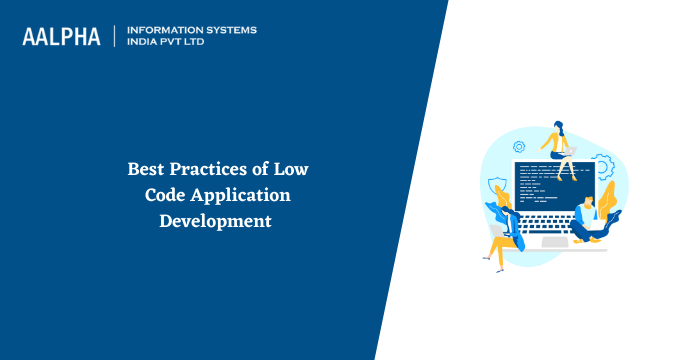Free Suggestions On Selecting Low-Code Platform Sites
Wiki Article
The Benefits Of Low-Code Development For Non-Developers In Terms Accessibility
The following key factors make low-code development available to non-developers.
Drag-and-Drop Builders: Low-code systems have drag-and-drop interfaces, which allow people who are not developers, and without the need to write code, to build visually appealing applications. This makes development more accessible to people with little or no technical knowledge.
WYSIWYG editor: "What you see is what you get" editors let users design interfaces, workflows, and other functions in a manner which closely resembles the final result. They are simpler to comprehend and utilize.
Simplified logic and Workflow Design
Visual Workflow modeling: Users design business flows and application logic with visual flowcharts. The models are simpler to use than traditional method of programming.
Pre-built Logic Components: Low-code platforms typically contain pre-built logic components (e.g. conditionsal statements loops) that are easily modified, eliminating the need for complicated programming.
Reusable components and templates:
Templates for libraries of pre-built templates Numerous low-code platforms have libraries that covers the most popular types of applications, providing those who are not developers a base to build upon and then customize.
Reusable widgets and modules: The development of a website is simplified through the use of reusable components and modules. This means that there is less necessity for a deep technical understanding.
Guided development and tutorials:
Step-by-Step instructions: Platforms offer tutorials and on-screen help for non-developers building applications.
Interactive Tutorials Interactive tutorials that are hands-on and interactive allow users to learn through doing, enhancing their comprehension and confidence using the platform.
Integration with existing tools:
Seamless Integrate: Low code platforms are designed to seamlessly integrate with the existing systems and tools in business (e.g. the ERP or CRM) This allows non-developers, to create applications that work with current workflows.
APIs/Connectors: The built-in APIs/connectors allow non-developers to connect their apps to external services.
Collaboration Features:
Team Collaboration: Features such as real-time collaborative workspaces and shared workspaces make it possible for non-developers to effectively collaborate with business analysts, developers and other key stakeholders.
Access Control based on Role: Users who are not developers can be assigned roles with the appropriate access levels. This allows them to contribute to the development without compromising security and functionality.
Automated testing and debugging:
Low-code platforms usually come with testing and debugging software that automates these processes. This makes it much easier for non developers to verify the functionality of their apps.
Error highlighting: The system provides information on issues and suggestions to guide non-developers.
The main benefit of low-code development in terms of accessibility for non-developers is in its ability to make development more accessible. Low-code platform platforms empower business users by offering them intuitive, visual and guided tools. They can then actively participate in developing and maintaining the applications. Follow the top rated https://www.wavemaker.com/low-code-application-development-platform/ for blog info including application development platforms, build a docker container, push notifications android, application modernization software, developing mobile apps, application development platforms, push notifications android, rapid app development, rad development, azure sql server and more.

The Advantages Of Low-Code Development For Governance And Security
Low-code applications offer several benefits for governance and cybersecurity and cybersecurity, which is essential to ensure that all apps are managed, well-managed and in compliance throughout their livescycle. These are the major benefits.
Unified Management Console : Low-code platforms offer a central management console that allows administrators to oversee and manage all applications. This allows for consistent governance across the company.
Role-Based Access Control RBAC (RBAC). These platforms often include robust access control that is based on roles, giving administrators the ability to define and implement their own access policies. Only authorized users are able to alter or access specific parts of a program.
The Compliance Process and Regulatory Adherence:
Built-in Compliance Features: Many low-code platforms are designed to comply with industry norms as well as regulations (e.g. GDPR, HIPAA). They provide frameworks and tools which help ensure that the applications are compliant with these standards.
Audit Trails and Logging: Comprehensive logging and audit trails are often combined, allowing businesses to monitor changes, track access and ensure compliance with internal as well as external laws.
Increased Security Measures
Data Encryption: Low-code systems typically provide built-in encryption for data that is in storage and while in transit, making sure that data with sensitive information is secure.
Security Certificates: A lot of low code providers have security certificate (e.g. ISO 27001 and SOC 2) which demonstrate their adherence to strict security standards. They provide an additional degree of security to clients.
Automated updates to ensure security:
Regular Security Updates and Patches Low-code platforms handle automated security updates, patches and updates. The applications are thus protected from current threats without the need for the intervention of developers manually.
Security Monitoring: Continuous security monitoring tools are used to send real-time notifications as well as information about potential security concerns.
Data Governance
Data Access policies These platforms assist organizations define and implement their data access policies and ensure only authorized users have access to data and that it is correctly used.
Data Masking and Anonymousization The built-in tools that mask and anonymize data help safeguard sensitive data when working in testing or development environments.
Consistent Lifecycle Application Management:
Development and deployment Pipelines Low-code platforms provide integrated pipelines for development and deployment, which include security checks. They make sure security is maintained through the entire lifecycle of the application.
Version Control: An integrated version control allows for the control of modifications. It also ensures that any changes made to the software are monitored and, if necessary reversed. This helps maintain the security of the program.
User Authentication, Authorization, and Authorization
Single Sign-On: The support for SSO as well as other sophisticated authentication methods simplifies the management of users and enhances security.
Multi-Factor Authentication : Many platforms include integrated multi-factor authentication, which adds additional security to accessing applications.
Policy enforcement and Compliance monitoring:
Low-code platforms are usually pre-defined with policy templates to help organizations implement security and governance policies quickly.
Compliance Monitoring Tools They provide regular monitoring and report on compliance status, making it easier to identify and address possible issues in advance.
Integration into Existing Security Infrastructure
Seamless Intergration: Low-code platforms are designed to allow seamless integration with the existing security tools and equipment, including Identity Management Systems SIEM Solutions (Security Information and Event Management), and Firewalls.
API Security: Built in API security features help protect data, maintain application integrity and ensure safe integrations.
Training and Best practices
A lot of platforms provide guidelines and best practices to secure development of applications. They help non-developers meet security standards.
Some lowcode providers offer resources and security training for users to understand how to create and maintain a secure application.
Overall the security and governance advantages of low-code application development make sure that applications are created and operated in a secure and compliant manner. These platforms provide all the tools and frameworks needed to protect sensitive data and enforce policies, while ensuring the regulatory compliance. See the most popular official source for Enterprise application development with Low-code Platform for blog tips including rapid applications, app platforms, application modernization, microsoft azure sql, rapid application design, lowcode no code, develop cross platform mobile app, develop mobile application, rapid application design, sso azure and more.

The Benefits Of Low-Code Development For Developing Applications In Terms Of Limitations And Customization
Low-code is an unbiased method that allows for substantial customization and overcomes weaknesses. Here are a few of the principal benefits: Handling limitations:
The Challenge of Overcoming Complexity
Low-code development platforms are easier to use since they offer pre-built components, templates, as well as various other tools. They also permit faster deployment of complicated applications.
Guided Workflows: Many platforms have guided workflows as well as wizards to help developers navigate through the maze of processes, decreasing the chance of making mistakes and guaranteeing consistency.
Scalability Solutions:
Built-in Scalability: Low-code platforms often include features that support an scalable architecture, which allows apps to take on more load without major redevelopment.
Performance Monitoring: The integrated tools for performance monitoring and optimization to ensure that applications are effective when they grow.
Security and Compliance
Low-code platforms are equipped with security features such as role-based security access control as well as encryption and automated checks to ensure compliance. These features address commonly-asked security issues.
Platforms are constantly changing their security procedures and measures of compliance, which guarantee that applications remain safe against new threats.
Customization:
Extensibility:
Low-code platforms tend to integrate custom-written code such as JavaScript or Python, allowing developers to expand their capabilities beyond the typical.
Custom Modules and plugins: Developers have the option of creating custom modules or plugins in order to customize specific functionality to fit unique business needs.
APIs and Integration
API Support: Full API support permits seamless integration of other systems and services. This allows for extensive customization and connectivity.
Third-Party Services: Low-code platforms usually provide pre-built connectors for popular third-party services, making it easier to connect and modify applications.
Flexible UI/UX design:
Customizable Interfaces Developers are able to design and modify user interfaces in line with specific branding and usability requirements which results in a custom user experience.
Responsive design: The ability to customize applications for different devices and screens is built-in.
The process of customizing Business Logic is easy:
Visual Workflow Builds: Visual tools that permit customization of business workflows and rules, and also to create complex customized processes.
Conditional Logic and Scripting: Platforms enable the inclusion of conditional logic as well as custom scripting to handle specific business rules and situations.
Data Management
Custom Data Models: Developers are able to create custom data models to satisfy specific requirements of an application and ensure that data handling is in line with the requirements of business.
Advanced Data Processor: The combination of advanced data processing tools and capabilities allows for the customization of how data is processed and used in the application.
Balance Customization and Limitations
Frameworks, Standards and Standards:
Best Practices: A low-code platform encourages compliance with industry standards and best practices. This is helpful in maintaining high quality, scalable and secured applications.
Governance Frameworks. Built in governance frameworks to ensure that modifications aren't detrimental to the integrity, security or the compliance of an application.
Iterative Development and Feedback
Rapid prototyping: By being capable of rapidly prototyping and test their modifications, developers are able to iterate on user feedback to improve the functionality of the application.
Continuous Improvement: Low-code systems support continuous improvement, allowing for continuous customization and improvement as business requirements evolve.
User Empowerment
Empowering Citizen Developers: By enabling non-developers to customize their applications using intuitive interfaces, low-code platforms expand the pool of contributors who can enhance and tailor applications.
Support and Training Information: Many platforms offer extensive training and support materials to help users customize applications without compromising stability or performance.
In the end, low-code application development provides a framework that is sturdy and adaptable enough to handle limitations while still allowing for the possibility of extensive customization. This allows companies to develop and maintain applications that work and adapted to specific business needs. All while maintaining high quality, security as well as scalability and standards.
